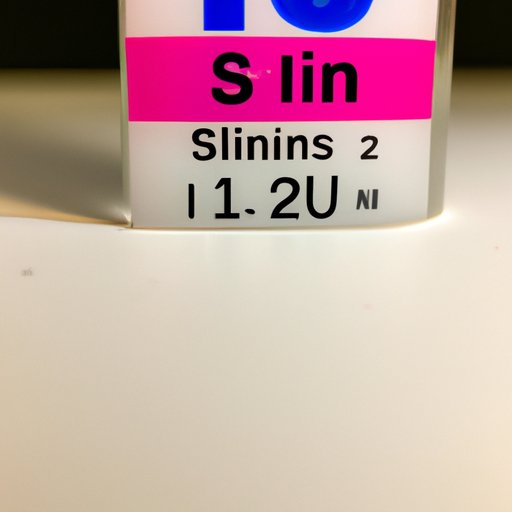Introduction
The International System of Units (SI) is an internationally accepted system of units used to express physical quantities. It consists of seven base units, which are the units of measure for seven fundamental physical quantities. These base units, along with derived units and prefixes, form the SI system, which is widely used in science, engineering, and technology-related fields. But what is a SI unit in science?
Exploring the Basics: What is a SI Unit in Science?
A SI unit is a unit of measurement defined by the International System of Units (SI). The SI system is based on seven base units, which are the units of measure for seven fundamental physical quantities: length, mass, time, electric current, temperature, amount of substance, and luminous intensity. These base units, along with derived units and prefixes, form the SI system, which is widely used in science, engineering, and technology-related fields.
Types of SI Units: SI units consist of two main types: base units and derived units. Base units are the units of measure for seven fundamental physical quantities, such as length, mass, time, electric current, temperature, amount of substance, and luminous intensity. Derived units are units of measure that are derived from the base units. Examples of derived units include the newton (a unit of force), the pascal (a unit of pressure), and the joule (a unit of energy).
Examples of SI Units in Science: SI units are used in numerous scientific fields, such as chemistry, physics, and biology. For example, in chemistry, SI units are used to measure the amount of a particular substance, the temperature of a reaction, and the pressure of a gas. In physics, SI units are used to measure the speed of an object, the force of gravity, and the energy of a particle. In biology, SI units are used to measure the size of organisms, the rate of metabolism, and the concentration of a substance.

A Closer Look at SI Units and How They Are Used in Science
Different Types of Measurements in Science: Scientists use different types of measurements when conducting experiments and analyzing data. For example, they may use measurements of length, area, volume, mass, time, speed, acceleration, temperature, pressure, and energy. All of these measurements can be expressed in terms of SI units.
How SI Units Help Scientists Make Accurate Measurements: SI units are important because they enable scientists to make precise and accurate measurements. By using SI units, scientists can ensure that their results are consistent and comparable across different experiments and measurements. This makes it easier to compare results between different studies and to draw meaningful conclusions.

Understanding the Role of SI Units in Scientific Measurement
How SI Units Facilitate Comparisons Across Different Measurements: By using SI units, scientists can make sure that the results of their experiments are comparable and reproducible. This allows them to make meaningful comparisons between different measurements and draw valid conclusions. For example, if two researchers measure the speed of a falling object using different units, it would be difficult to compare their results. But if both researchers use the same SI unit, such as meters per second, then their results can be easily compared and accurately analyzed.
How SI Units Enable Scientists to Share Results With Each Other: By using SI units, scientists can also share their results with each other more effectively. By expressing measurements in terms of SI units, scientists can ensure that their results are understood by other researchers, regardless of their location or field of study.
How SI Units Enable Accurate Measurements in Science
Advantages of SI Units for Making Accurate Measurements: SI units provide several advantages for making accurate measurements. First, SI units are standardized, so all measurements made in SI units will be consistent and comparable. Second, SI units are well-defined and easy to understand, so anyone can interpret measurements expressed in SI units. Finally, SI units are universal, so they can be used to make measurements anywhere in the world.
How SI Units Reduce Uncertainty in Measurements: By using SI units, scientists can reduce uncertainty in their measurements. Since SI units are standardized and easy to understand, scientists can be confident that their results are accurate and reliable.

A Guide to Understanding SI Units in Science
Step-by-Step Guide to Using SI Units in Science: When using SI units, it is important to first determine the type of measurement you are making. Then, identify the appropriate SI unit for that measurement. Finally, use the correct prefix to express the measurement in SI units. For example, if you are measuring the speed of an object, the appropriate SI unit is meters per second. The prefix “kilo” can be used to express the measurement in kilometers per second.
Tips for Calculating SI Units: When calculating SI units, it is important to remember to convert all measurements into the same SI unit before performing any calculations. For example, if you are trying to calculate the speed of a moving object, you should convert the distance and time measurements into the same SI unit, such as meters and seconds, before calculating the speed.
Unpacking the Definition and Significance of SI Units in Science
History of SI Units: The SI system was developed in the late eighteenth century by French physicist André-Marie Ampère. He proposed a system of units based on seven fundamental physical quantities, which he called the “absolute system of units.” This system was later adopted by the International Committee for Weights and Measures and became known as the International System of Units (SI).
Impact of SI Units on Science: SI units have had a profound impact on science. By providing a standardized system of units, SI units have enabled scientists to make accurate and reproducible measurements. This has allowed them to draw meaningful comparisons between different experiments and to share their results with each other more effectively.
Conclusion
In conclusion, a SI unit is a unit of measurement defined by the International System of Units (SI). SI units are used in numerous scientific fields, such as chemistry, physics, and biology. They enable scientists to make accurate and reproducible measurements and facilitate comparisons between different measurements. Additionally, SI units have had a significant impact on science by providing a standardized system of units.
(Note: Is this article not meeting your expectations? Do you have knowledge or insights to share? Unlock new opportunities and expand your reach by joining our authors team. Click Registration to join us and share your expertise with our readers.)
